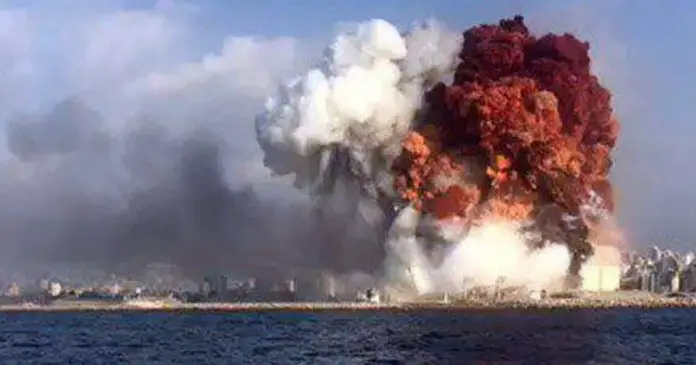The Top 5 Largest Non-Nuclear Explosions by Magnitude
| Event | Date | Yield (kilotons) |
Location | Deaths | |
|---|---|---|---|---|---|
| 1 | N1 Rocket Explosion | July 3,1969 | 7.0 kt | Baikonur Cosmodrome, Soviet Union | N/A |
| 2 | Minor Scale and Misty Picture High Explosive Tests | June 25,1985, May 14,1987 |
4.8 kt | White Sands, NM, USA | 0 (test) |
| 3 | Operation Big Bang: Heligoland Islands | April 18,1947 | 3.2 kt | Heligoland Islands, UK | 0 (test) |
| 4 | The Halifax Explosion | Dec 6,1917 | 2.9 kt | Halifax, Nova Scotia, Canada | 1,963 |
| 5 | The Beirut Explosion | Aug 4, 2020 | 2.75 kt | Beirut, Lebanon | 220* |
 Special Report
Special Report
This Top 5 List is Measured in Kilotons of TNT, so What Exactly is a Kiloton?
A kiloton is the equivalent of 1,000 tons of TNT and 1,000 tons of TNT sure is a lot. We could talk about TNT equivalencies and gigajoules and all that science stuff and everything, but why don't we just show you what a one kiloton explosion looks like instead?
The Russian Rocket that Blew Up Big Time
The N1 Rocket was the Soviet counterpart to the USA's mighty Saturn V rocket. The N1's first stage is still the most powerful ever built and it had over 30 engines and was a pretty darn complicated piece of Russian engineering at the time. That's probably why it blew up. The Russians really wanted to beat the American Saturn V rocket to the moon by giving their rocket lots and lots of thrust (lots), however the poor reliability of the N1 Rocket was blamed upon its overly complex design and probably too many engines, and, on July 3rd, 1969 it exploded like a mini-nuclear bomb on the launchpad.
It is considered to be the largest man-made non-nuclear explosion of it's kind in history. Accurate casualty information on that explosion is really hard to come by, because hey, we're talking the 1960´s Soviet Union here, but we really doubt it was zero. By the way, the Russians may have messed that one up but they hold the impressive record for the most powerful nuclear bomb/explosion ever, otherwise known as the "Mother of All Bombs." We here at Top5ofanything.com find it ironic that the Russians have caused two of the largest explosions on the face of planet earth; one that they definitely did not intend, and one that they very much did.
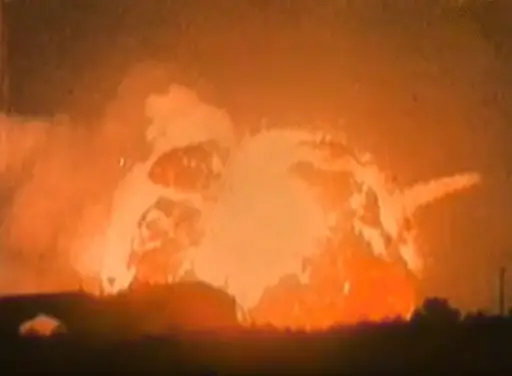
America Sets Off the Second Biggest Explosion Ever
In 1985, while the world was listening to "Careless Whisper" by Wham*, The United States Defense Nuclear Agency (DNA) decided to make a big "WHAM" of their own and detonate the second largest non-nuclear explosion known to man. Minor Scale and Misty Picture (we're just as confused about those names as you are) were conventional explosions used to simulate the explosion of a small nuclear bomb. Mission accomplished. The explosive charge consisted of 4,685 tons of pure ammonium nitrate and fuel oil (AKA "Satan's Cocktail from hell"). The DNA wanted to find out what an "almost" nuclear explosion would do to their jeeps and buildings and other super-expensive military hardware. Just another day at the office really.
*Careless Whisper was the number 1 song in 1985.
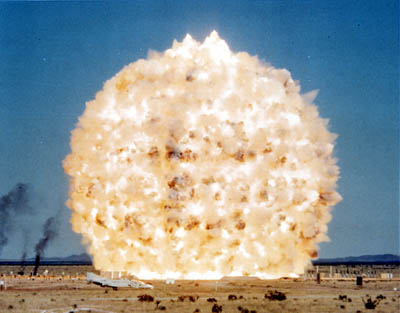
The British Make a really BIG Bang
The British Royal Navy, probably because they absolutely wanted to thumb their nose at the Germans after the second world war, used the previously German uninhabited Heligoland Islands as a bombing range from 1945 to 1952. One day they decided they needed to dispose of all their thousands of pounds of unexploded ordinance (6,800 tones to be exact) which they called "Operation Big Bang" because the British are well-known for their extremely dry wit. So they went ahead and caused the third biggest bang on our top 5 list.
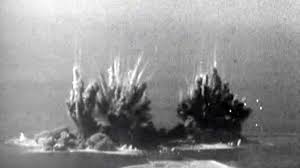
The Halifax Explosion was Hell on Earth
The Halifax Explosion, which took place in Halifax, Nova Scotia Canada, was the largest man-made (accidental) explosion of the pre-nuclear era. It is hard to overstate the devastation that it wrought on the city. The entire residential and business area around Halifax harbour was leveled. It was completely destroyed. It left an estimated 2,000 people dead, 10,000 people injured and over 6,000 homeless.

When the Imo, a Norwegian steamship carrying supplies for the Belgian Relief Commission, left Halifax harbour on December 6, 1917, nobody could have foreseen catastrophic events that would unfold shortly after 9am that fall morning. Neither could the crew of the French steamship Mont-Blanc who were steaming peacefully into Halifax harbour until they noticed that the Imo was off course and they were on a collision course with the other ship. It might have been a "normal" seafaring accident with little of no loss of life if it weren't for the fact that the Mont-Blanc was carrying one hell of a lot of explosives, flammable chemicals and military ordinance.
Around 2.9 kilotons of it to be exact. The catalyst though, was the 246 tons of benzol, one of the most flammable and unstable fuels there is. The benzoil had been stored in drums, lashed to the deck of the Mount-Blanc and when the Imo strayed off course and collided with the explosive-laden military ship, the benzoil spilled and caught fire fast. Within seconds, the Mount-Blanc quickly became a deadly, ticking time-bomb. The crew, unable to control the fuel-fed blaze, abandoned ship. 20 minutes later the burning vessel, now a ghost ship, drifted into the busy and very crowded Halifax harbour.
It must have been quite a spectacular sight. A burning military ship adrift in the harbour approaching the pier. Firefighters trying to extinguish the blaze, curious onlookers gathering to get a better look, people looking out the windows of their homes at all the commotion. They had no idea what was about to hit them.
When the Mount Blanc, loaded with 2,366 tonnes of picric acid, 256 tonnes of TNT, 62 tonnes of guncotton and 245 tonnes of benzol, exploded, it blasted forth a furious torrent of hot gas, burning tar-oil and razor sharp shrapnel.
large chunks of the what used to be a ship, hurled into the populated area of the docks and the houses above them. It obliterated people, buildings, homes, businesses, other boats in the harbour, and even trains that were stationed in the area at the time. More than 500 train cars were either damaged or completely destroyed and over 60 railway crew killed. The explosion also caused a tsunami that drove itself into the centre of the city, destroying thousands of buildings, and taking many lives with it. A whole Mi’kmaq aboriginal fishing village also disappeared, completely washed away by the force of the tidal wave.
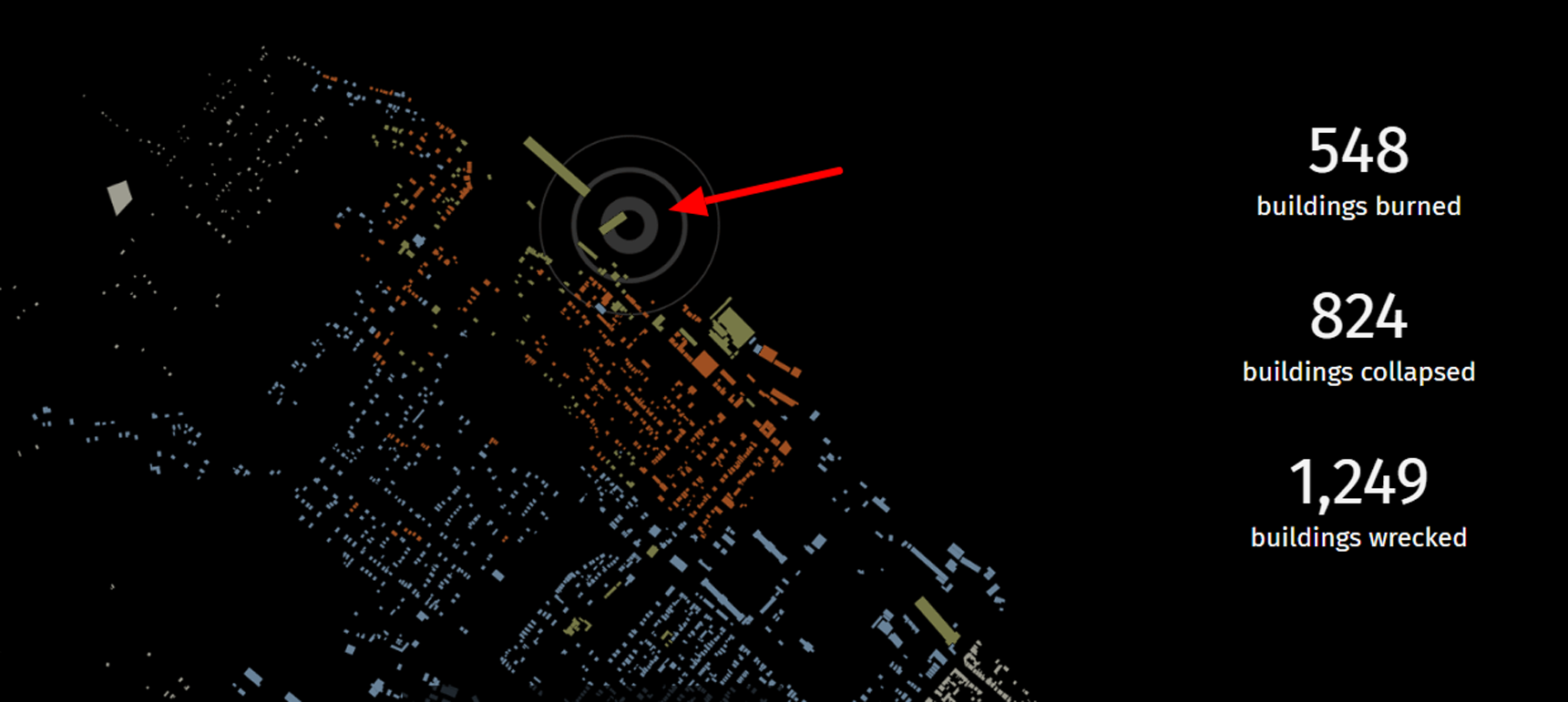
All that death and destruction happened within about 5 minutes. 1,600 people were killed more or less instantly. The city of Halifax was on fire, bodies and debris were strewn everywhere on land, in their homes and in the water. Some were hanging from telegraph wires. In his own words, here is a Royal Navy sailor named Frank Baker, who wrote the only known eyewitness account of the terrible aftermath of the explosion:
““The N.W. part of Halifax was in total ruins and fires were springing up all over the city. Part of the railway was completely demolished and everywhere were dead and dying among the ruins. When we arrived at the hospital, the windows were all blown out and the wards were two feet deep in water owing to all the pipes having burst. The town was literally ablaze, the dry dock and dockyard buildings completely demolished and everywhere wounded and dead. The theatres and suitable buildings were all turned into hospitals or shelters for the accommodation of the homeless. Naval and Military pickets were patrolling the streets endeavouring to keep order. Poor little kiddies homeless, their parents having perished, were crying piteously and anxious relatives were inquiring for their dear ones.We visited the part where the fires were at their worst, and it is beyond me to describe the absolute terror of the situation. For miles around nothing but a flaming inferno, charred bodies being dragged from the debris and those poor devils who were left still lingering were piled into motor wagons and conveyed to one of the improvised hospitals. We returned to our ship at 11pm sick at heart with the appalling misery with which the city abounded. The glare from the fires lighting the harbour up like day.”
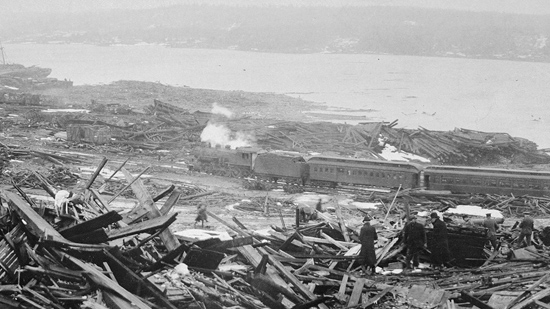
And after all that destruction and devastation, and if that wasn't enough, the next day a Canadian winter storm hit the city and complicated things even more for the victims and relief workers. When the news of the disaster spread to America, the good people of Boston took notice. They began to mobilize a huge and immediate aid and disaster relief effort for the people of Halifax. Crews of doctors and nurses and other relief workers were sent practically overnight and they were sorely needed and very welcome. The people of Halifax never forgot it. To this day the government of Nova Scotia carefully selects a Christmas tree (the Nova Scotia government has very specific guidelines for selecting the tree) to be placed and lit on Boston Common for the people of Boston to enjoy throughout the holiday season.
It is true that most awful tragedies of this kind of scale have their heroes, and like the people of Boston who organized aid for the city of Halifax, Railway dispatcher Vince Coleman is one of those heroes. He is credited with saving many lives that day in December, dying at his post while continuing to send out urgent telegraphs warning of the impending explosion. Most Canadians who grew up watching Heritage Moments on national television will remember this video which puts a human face on the tragic events of the past.
The August 2020 Beirut Explosion
On August 4th, 2020 approximately 2,750 tons of ammonium nitrate exploded in the port of Beirut killing at least 220 people and injuring more than 6,000. The Lebanese government estimates that up to 300,000 people have been displaced by the blast. The numbers are rising. Early reports indicate that the highly explosive material was being stored in a warehouse since at least 2014, after being seized from a ship that was docked in the harbour. The blast was immense. The shockwave from the explosion was felt up to 200 kilometres away from the epicentre and registered the equivalent to a 3.3 magnitude earthquake. Videos of the Beirut explosion show exactly how powerful these types of incidents can be.
This recent explosion and the videos that people took of it, was shocking to behold and and as mentioned above, has given us an insight into the almost atomic-brute force of these kinds of explosions. The Beirut blast has knocked the Texas City explosion off the number 5 spot on our top 5 list.
Here is a video compilation that shows the incredible destructive power of these types of explosions:
 Noel James Riggs, Madrid Spain.
Noel James Riggs, Madrid Spain.
Sources: Top 5 of Anything.com big explosions research.
List Notes: Data is the Top 5 Largest Non-nuclear explosions caused by mankind by magnitude or yield in kilotons of TNT. Data does not include explosions caused by nature. List is accurate as of August 2020.
